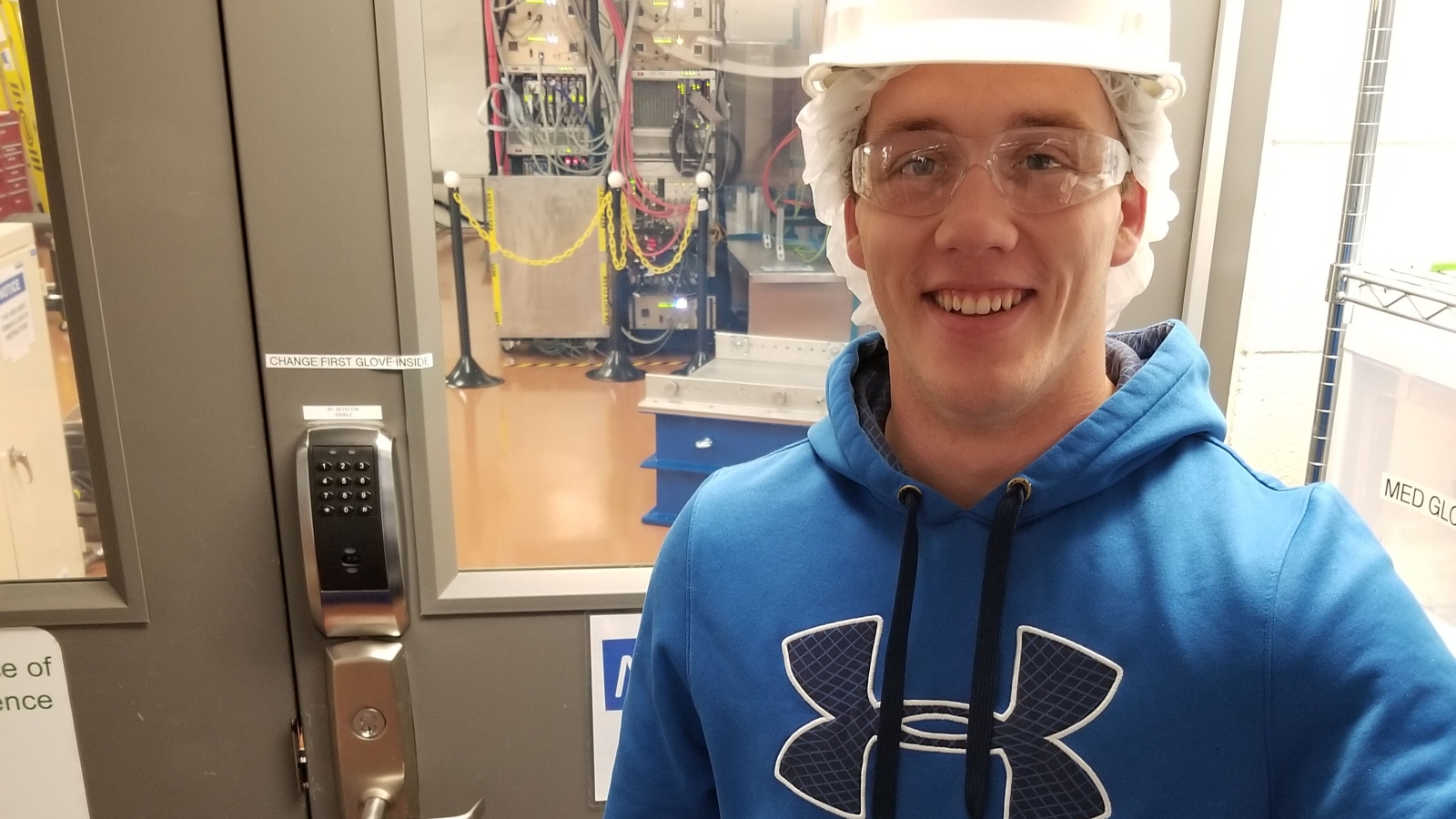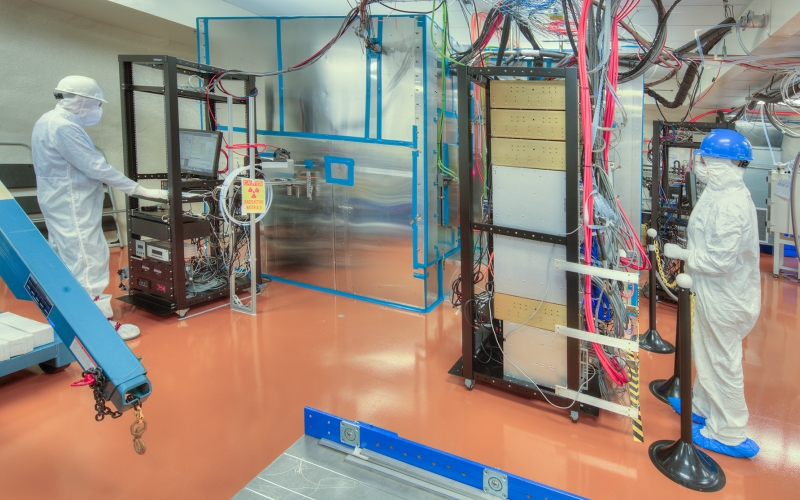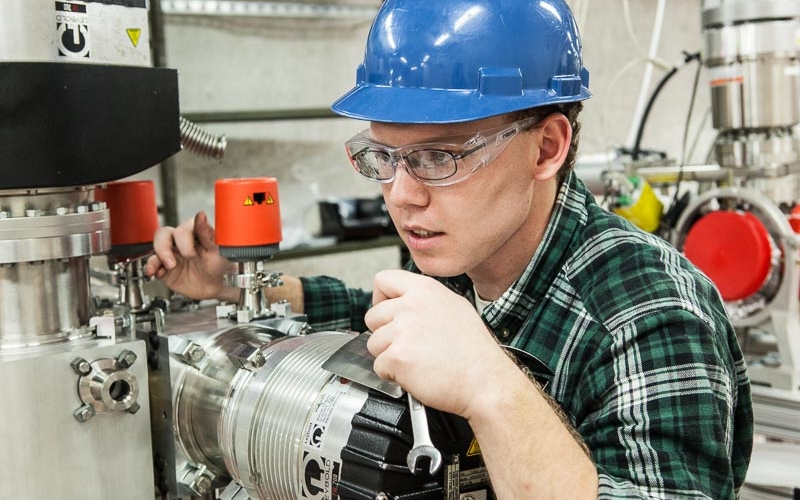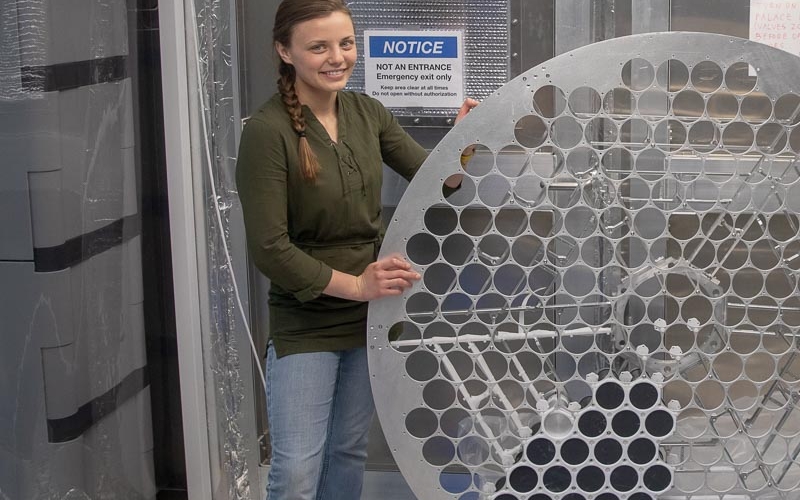
Brady Bos prepares to enter the Majorana cleanroom.
For the past four years, Brady Bos has been piecing together a 4,000-piece jigsaw puzzle. You wouldn’t think it would take so long to put a puzzle together until you realize that for all of those years Bos was a full-time student at the South Dakota School of Mines & Technology (SD Mines), worked with the Majorana Demonstrator Project to build the highly complex experiment and shield, developed modeling of radon, and studied for the GRE (graduate record examinations).
“He blew the GRE right out of the water—especially the math section,” said Cabot-Ann Christofferson, an instructor at SD Mines who works extensively with the electroforming for Majorana.
With his Bachelor of Science degree in physics and applied and computational mathematics in hand, Bos heads to the University of North Carolina (UNC) this fall where he will begin a new phase in his educational career: that of graduate student.
“I’m really excited,” Bos said. “It’s going to be a fantastic challenge, and I’m all about challenging myself.”
As a graduate student, Bos will continue to work on the Majorana project, with plans to transition along with many members of the team to the LEGEND (Large Enriched Germanium Experiment for Neutrinoless ββ Decay). The collaboration was formed in 2016 and includes members of Majorana, the GERDA (GERmanium Detector Array) collaboration and other researchers in this field.
“That’s one of the main reasons I wanted to go to UNC,” Bos said. “I’ll get to work with a lot of Majorana collaborators. I think I bring a lot of experience to the collaboration, and I’m hoping to make a large contribution to the new project.”
Bos certainly made a contribution to the Majorana project, Christofferson said.
“Brady helped build the shield, worked on electroforming the copper and cleaning the pieces that went into the experiment, assisted in the machine shop and helped with computer modeling of the radon in the shield and performed a test to see how that model matches up,” she said. “That’s all graduate-level work, and he really impressed upper level scientists with Majorana.”
But the work goes a long way toward preparing undergraduates for the grueling work that lies ahead as a graduate student.
“It’s important for physics graduate students to be involved in the construction of the experiment that provides data for their thesis,” said Jaret Heise, science director at Sanford Lab. “Students get a much better appreciation of how detectors work when they help with the nuts and bolts. Scientific instruments are not ideal mythical devices, but rather real-life objects with personality quirks, and it’s impossible to do the science without that level of understanding and appreciation.”
As a former Ph.D. student at the University of British Columbia (Canada), Heise knows of what he speaks. He was stationed at the Sudbury Neutrino Observatory (SNO) in Sudbury, Ontario, the deepest underground research laboratory in North America.
“I was thrilled by the initial experience of working underground on an amazing experiment (even if the initial work wasn’t glamorous—I started by cleaning the large 40-foot diameter acrylic sphere with bug sponges!),” Heise said. “I worked on many phases of the SNO experiment, including construction, commissioning and operations. My graduate student experience really set the direction of my career.”
Heise went on to become the Detector Operations Manager for the SNO experiment and, ultimately, the Science Director at Sanford Lab. He credits his work on SNO and believes the proximity to Sanford Lab gives physics students—like Bos—valuable research opportunities to work on complex projects with experts in the field.
“Graduate students often become collaboration experts on detectors or systems they develop and help build,” Heise said. “Wherever their career takes them, a well-rounded physics graduate education provides students with analysis and problem-solving skills that are valuable across the board.”
That’s exactly what Bos is looking for. He hasn’t decided exactly what he wants to do, but he’s knows it’s either research or teaching. Or both.
“I want to work at a national laboratory or teach at a university and I think my experience here and as a graduate student will make me a better scientist or teacher,” Bos said. “I want to get as much experience as I can because it gives you a different perspective and helps you do a better job.”
But like that 4,000-piece jigsaw puzzle that is still in progress, Bos knows the road ahead is a long one—and will require at least 6 years before he reaches the end.
“It takes a lot of patience, a lot of staring at things and trying to figure them out,” he added. “I’m going to work as hard as I can and get all the experiences I can while I'm in graduate school.”


